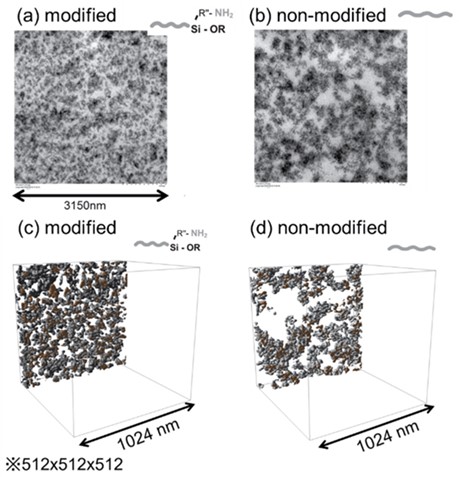-
PDF
- Split View
-
Views
-
Cite
Cite
Katsumi Hagita, SM-5
Computational Geometry Analysis of Aggregations of Nanoparticles Filled in Rubbers through FIB-SEM Observations, Microscopy, Volume 68, Issue Supplement_1, November 2019, Page i9, https://doi.org/10.1093/jmicro/dfz058Close - Share Icon Share
Filler-filled rubber is of great interest as a system in which the 3D structure of fillers in a volume from nanometer to micrometer dimensions greatly influences the structure-property relationships. For the cases of tire rubbers, fillers’ nanostructure (morphology), whose order is 100nm, is important on their mechanical functions such as fuel efficiency. When the fillers were more dispersed, rolling resistance became smaller. To realize high-fuel-efficient tire, silica nanoparticles (NPs) were used as fillers in order to disperse fillers’ aggregations with coupling agents. Note that carbon black NPs have been used for the conventional tire rubbers. Recently, in order to further improve the dispersity, a polymer modified so that the polymer-ends adsorb to fillers was used. Figure 1 (a,b) shows TEM observations for the modified and non-modified SBR (styrene-butadiene rubber) [1]. Difference of dispersity was clearly found. Here, the primary shape of the silica NPs can be regarded as a sphere whose diameter is a few ten nanometers. NP-morphologies in a volume of micro-meter dimension is important. To investigate characteristic structures in the scale of 1 μm dimension, ultra small angle x-ray scattering (USAXS) experiments were extensively performed. In our previous work [1], we estimated 3D structure models of NPs from USAXS-data by using reverse Monte Carlo (RMC) searches. Here, we achieve 3D modeling of NPs configurations under the periodic boundary box with the cubic-dimension of 9 μm. The snapshots of the estimated 3D structures were very similar to those of TEM. According to our evaluation of the reproducibility of the RMC method [2], the reproducibility of the statistical properties of the geometric quantities was examined using the coarse-grained molecular dynamics simulations of the gel filled with NP as reference data. We found that the reproducibility of the neighboring structures of NPs was not good, but the reproducibility of the middle-range structure between the NP aggregates was good. Thus, to perform computational geometry analysis based on mathematics, we need a method that can evaluate the structures of neighboring NPs with high reliability. That is 3D microscopy such as 3D-TEM and FIB-SEM.

(a,b) Snapshots of TEM observations and (c,d) FIB-SEM observations.
Recently, we have performed FIB-SEM observations to grasping the morphologies of NPs in large volume [3]. As shown in Figure 1 (c,d), clear difference of NPs’ aggregations between the modified and non-modified SBR can been seen. The volume fraction of NP in this system is 16%, and the aggregates of NPs can be regarded as isolated clusters. Here, since the larger clusters were larger than the observation range (1 μm), appropriate statistics are not easy for larger clusters. Taking advantage of the features of FIB-SEM observations, we investigated the statistical properties of dispersed medium-sized clusters in detail. Note that by using 3D watershed segmentations [4], we confirmed that the number segmented into individual NPs roughly agreed with the value estimated from the average NP-diameter of 18.8 nm. Here, we should remind that the degree of dispersion of the diameters was not small (0.2). We can conclude that FIB-SEM observations can capture individual NPs in rubber.
From viewpoints of computational geometry analysis, we investigated characteristic behaviors of the observed isolated clusters of NPs. Detail results and discussions are given in this presentation.
1. K. Hagita, T. Tominaga, T. Sone, Polymer 135 (2018) 218-229.
2. K. Hagita, Soft Matter (2019) in press.
3. K. Hagita, T. Higuchi, H. Jinnai, Sci. Rep. 8 (2018) 5877.
4. R. Yamamoto, et al, a poster presentation in this symposium (2019).



